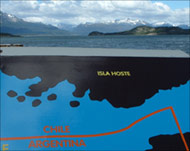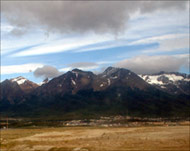Boom time at the End of the Earth
It’s a bleak, rugged, unforgiving place. With roads cut off by snow for months of the year where the day lasts just six or seven hours, Tierra del Fuego at the extreme foot of South America is a land at the end of the earth.

It’s a cold, barren landscape of broken trees, hardy plants, ice and snow.
Yet in the main high street of the principal town Ushuaia the modern internet cafe is a-buzz at midnight with American, German and Swedish accents and with Britney Spears blasting from the MTV video screen in the corner.
This forgotten wasteland split between Argentina and Chile is awash with high-season travellers, their numbers breaking all records this year and packing all available space in the 61 restaurants each night.
It’s boom time at the end of the world. Suddenly visitors are up by a third on 2003, with over 200,000 passing through the last stop to Antarctica.
Ubiquitous smiles
Big money is coming with the Sheritan Hotel chain welding a new 5-star hotel on the side of a glacier and a 40% rise in accommodation being built as fast as construction teams can make the most of the summer months.
 |
|
Tourism is booming in this region |
After years in the wilderness, the smiles on the faces of the local population of 45,000 Fuegians are ubiquitous.
Luis Turi arrived 10 years ago from northern Patagonia in Argentina to set up a trekking and mountaineering company.
“This is good time for all of us, ” he said with a broad grin.
“Tourism is growing every year. The fall of the value of the peso against the dollar was a principal factor. The other was the sense of security compared to other destinations especially due to the war in Iraq,” he said.
Ushuaia was once famed for its incredibly short island airport runway – extremely dangerous in the blizzards and winds lashing in from the Roaring Forties. Now with an international aiport completed in 1999, it has captured a slice of the tourist market with its ubiquitous slogan: “Ushuaia: the end of the world.”
Lifetime’s trip
The big draw is that this is the southernmost town in the world reachable by road, the climax of the Pan-American highway. It is also the take-off spot for top-dollar cruises on ancient Soviet-era hulks into the Antarctic, just 48 hours away.
“It’s just breathtaking, a trip of lifetime,” said Thomas Bregg, 60, weather-beaten, red-faced and just back from an cruise through the ice.
 |
|
The strange landscapes of Tierra |
“You really feel like you have just fallen off the end of the earth.”
Ushuaia is also in a spectacular setting at the foot of the Darwin Range of snow-capped mountains reaching 1500 metres above sea-level.
Adventure sports such as ice-climbing, trekking and mountaineering bring in the younger generation.
“The mountain for all of us is a passion. You must take into account that much of this land is untouched by human hands,” Bregg said.
Amazing turnaround
Luis, who has authored a new bilingual guide to climbing the precarious peaks, said, “It is an eco-system that we are determined to protect.”
It’s an amazing turnaround for a place with last tasted international fame as the naval base from which General Leopoldo Galtieri launched the junta’s ill-conceived attempt to “reclaim” the nearby Falkland Islands from Britain as a last-ditch bid to bolster the fading murderous Argentinian dictactorship in 1982.
 |
|
Ushuaia, the town nestled at the |
The impact of the war over Los Malvinas has left a deep scar here, with a giant steel monument to the 655 Agentinian dead taking a prominent polace on the bay.
Tourist offices display patriotic stickers from the 20th anniversary which reads: “Los Malvinas, Tierra del Feugo is waiting for you.”
The orginal inhabitants of the these lands are long since gone: victims of the white man’s diseases – tuberculosis, measles and typhoid – and from lack of food after intensive whale and seal hunting.
The Yamana Indian population dropped catastrophically from 2500 in 1860 to just 300 in 1893 and then virtually disappeared.
‘Gloomy forest’
Charles Darwin had famously documented with fondness these formidable islanders in his seminal Voyage of the Beagle which led to the naming of what translates as the Land of Fire and of the Beagle Channel.
“The savages followed the ship, and just before dark we saw their fire, and again heard their wild cry. The harbour consists of a fine piece of water half surrounded by low rounded mountains of clay-slate, which are covered to the water’s edge by one dense gloomy forest.
|
“A single glance at Charles Darwin quoted in Voyage on the Beagle |
“A single glance at the landscape was sufficient to show me how widely different it was from anything I had ever beheld, ” he wrote in December 1832.
From the start of the 20th century until 1947 Ushuaia became a prison island – Argentina’s Siberia. Mass murderers and political prisoners alike were shacked and dressed in yellow and black striped uniforms in one of the harshest climates on the planet.
Now the prison has been turned into a museum and is yet one more attraction for the travelling hordes descending on the 18,000 square mile island.
Wild coast
Catamarans whisk sightseers off to watch sea lions and Magellan penguins on nearby islands but it is the less exotic species which have been introduced – sheep, rabbits and beavers – which are most common and have had the most impact on the environment.
Still, the chance to see a guanaco – a distant relative of the camel with a kangeroo-like ability to run and jump – is worth the fare, as are the condors, hawks, red-headed woodpeckers and other species of birds which populate the wild coast.
Ironically, considering the all-consuming success of the “Fin del Mundo” slogan, Ushuaia is actually usurped by the Chilean military base of Puerto Williams across the other side of the Beagle Channel.
It might not be the southernmost town of the planet but for the people of Ushuaia, it’s not the end of the world.